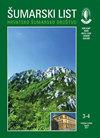Jesu li testovi praćenja oksidacijskog stresa dovoljni za genetički monitoring hrasta lužnjaka u malom razmjeru?
IF 0.4
4区 农林科学
Q4 FORESTRY
引用次数: 0
Abstract
Although being present much widely in terms of its geographical distribution, pedunculate oak (Quercus robur L.) represents one of the crucial species in forest ecosystems in South Eastern Europe. We wanted to contribute to existing efforts in designing genetic monitoring methodology for this noble broadleaved species, through the screening of genotypes with different health status and belonging to two phenological varieties [early (var. praecox) vs late (var. tardissima)] using seven oxidative stress parameters (total protein content, total phenolic compounds content, total flavonoids content, DPPH, ABTS, NO radical scavenger activities and Ferric reducing antioxidant power essay - FRAP). Results of this study provided significant biological message, contributing to better understanding of existing biodiversity of pedunculate oak in Serbia. Four out of seven oxidative stress screening tests (total phenolic compounds content, total flavonoids content, RSC NO and FRAP) clearly discriminated late vs early individuals sampled from selected pedunculate oak gene pool. Although presented results did not show significancy in using mentioned parameters to distinct damaged from vital individuals, nevertheless, knowledge gained through discussion and comparison with previous studies contributed to precise determination of biochemical tests which might be used in future efforts of genetic monitoring of this species.氧化应激监测测试是否足以对小型豪华花园进行基因监测?
有花序栎(Quercus robur L.)是东南欧森林生态系统中的重要树种之一,其地理分布十分广泛。我们想为现有的努力在设计遗传监测方法这一崇高的丘陵山地物种,通过筛选属于两个基因型不同的健康状况和物候品种(早期(var.早熟)和后期(var. tardissima)]使用七氧化压力参数(总蛋白质含量、总酚类化合物含量、总类黄酮含量,DPPH, abt,NO自由基清除活性和铁还原抗氧化能力(FRAP)。本研究结果提供了重要的生物学信息,有助于更好地了解塞尔维亚有花序栎的现有生物多样性。7项氧化应激筛选试验(总酚类化合物含量、总黄酮含量、RSC NO和FRAP)中有4项对有花序栎基因库的晚期和早期个体有明显的区分。虽然所提出的结果在使用上述参数区分受损个体和重要个体方面没有显着性,但是,通过与先前研究的讨论和比较所获得的知识有助于精确确定生化测试,这可能用于该物种未来的遗传监测工作。
本文章由计算机程序翻译,如有差异,请以英文原文为准。
求助全文
约1分钟内获得全文
求助全文
来源期刊

Sumarski List
FORESTRY-
CiteScore
0.90
自引率
20.00%
发文量
32
审稿时长
>12 weeks
期刊介绍:
Forestry Journal publishes scientific and specialist articles from the fields of forestry, forestry-related scientific branches, nature protection and wildlife management.
 求助内容:
求助内容: 应助结果提醒方式:
应助结果提醒方式:


